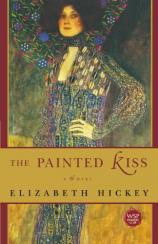Reading Group Guide
Discussion Questions
The Painted Kiss

1. Discuss the experience of reading a novel that explores the lives of historical persons. In what way is it different from reading a wholly fictional story? What, if anything, did you know of the artist Gustav Klimt before reading this book? Did the story contradict or expand on anything you knew? Did the character you grew to know in this story surprise you?
2. This story is told during two different periods of time in Emilie Flöge's life: the late 1800's the mid 1900's. Why do you think the author choose to tell it in this way? What kind of perspective do we gain from the older, wiser Emilie, who is portrayed against the backdrop of WWII? How might this novel have been different had it unfolded in a more linear fashion?
3. Emilie has been raised in a world where outward appearance means everything. Taught from an early age that women, especially, should be more concerned with how they present themselves than with how they feel or what they think, her relationship with Gustav is iconoclastic for her. Not only is he interested by her innermost thoughts and feelings, but he shows little interest in the world of polite society. Talk about what Gustav symbolizes for the young girl. In what ways does he challenge the reigning views of this particular time in history? How does his role as artist allow him to do so?
4. Gustav and Emilie share similar artistic temperaments. While Emilie's salon, even very early on, is a raging success, she struggles to maintain artistic integrity, despite the fact that her customers, more often than not, are less interested in art. As she points out, "That was the drawback of trying to make money. Sometimes you had to sacrifice taste altogether" (229). We see this over and over again with Gustav's art as well -- artistic vision often clashes with the bottom line. Discuss the way that this concept is explored in this novel. Is there any solution for artists, a way for them to remain true to their ideals without starving? Talk about the ways that this debate continues in today's world.
5. At one point, Gustav paints a picture of Emilie in a dress that she has made. Emilie is somewhat frightened by the outcome, asking, "Is this really what you see when you look at me?" Klimt's response is more about the nature of art than the particular painting, as he explains: "It would be easy to repress it as rational and orderly, like the School of Athens, but that would be dishonest. It's completely terrifying to make visible the chaos of human existence, to admit the darkness of the human mind, but once you've done it you can see there is light there" (198). What significance does this idea have in terms of the larger story? How do artists like Klimt show the dark side of life, while also giving hope? Is there hope to be found in this story?
6. Late in the novel, Emilie explains how Gustav keeps their relationship private: "I am not a subject he [Gustav] ever discusses, not with Hoffman, not with his mother, not with anyone. I am in his life and he does not want to know why, or in what way" (208). Does this quotation illuminate the nature of their relationship? Why is it so important to Gustav that Emilie not be discussed by other women?
7. Along the same lines, why does Gustav feel the need to compartmentalize the women in his life? While he treats Emilie as a companion and a kindred spirit of sorts, one who (except for rare occasions) is not to be sullied by physical passion, he has seemingly little trouble bedding and carrying on with other women. As long as these two worlds do not meet, he seems somewhat satisfied. What might this say about his personality? Why does he place Emilie on a pedestal, while every other woman is fair game? Is it hypocritical, or does it betray the counter culture ideals that he espouses, that he wishes to keep Emilie pure?
8. What about Emilie's part in this relationship? Why, at the sake of her own happiness, does she spend her youth in a perpetual state of limbo with a man that she knows will never marry her? Does Emilie have a self-destructive side, which allows her to fritter away her time (as some might describe it) with Gustav, or do you think she really believed that one day he would be hers? Is it possible that Emilie is drawn to Gustav precisely because she cannot have him? What do you think the author would say?
9. Adele, perhaps one of Gustav's most interesting mistresses and one of his most well-known subjects, is a difficult character to unpack, both for our protagonist, and for the reader. Pampered though she is, she exudes melancholy to the point of being tragic. At one point, as she talks with Emilie about what kind of new dress she would like, she states, "I have no needs - only unfulfilled desires" (224). Discuss the nature of desire as it is presented by Adele in the novel. What distinction is there between a need and a desire and why does Adele feel the need to call attention to it? In what ways might Adele be representative of women in her social class? Why is she so unhappy, so filled with ennui, despite the advantages that she has as a woman of wealth?
10. Ruminating on Gustav and his relationship to his work, Emilie thinks, "Some critics said that he didn't care about his sitters, he was only interested in the thickets of design he built up around them, but that was not true. The portrait said what was important to say about Adele. It said plenty about him too; he was in love with her when he painted it, of that I am sure" (240). Klimt is a somewhat elusive character in this story, as he is only presented through the eyes of Emilie. Her viewpoint is not only subjective in the way that all viewpoints are, but also because she's in love with the man and perhaps sees a side of him that others may not. To what extent should we trust our protagonist? Is her view a wholly reliable one? Do you agree with her assessment of Klimt, or do you think that she might be blinded by her feelings?
11. Late in the novel, as Emilie observes some paintings of Adele, famous paintings that she has been "charged with protecting," she fantasizes about destroying them. What makes her want to do damage to Klimt's work and why does she ultimately refrain? How does this moment represent the complicated relationship between Emilie and Gustav?
12. To the Gustav Klimt of this novel, "The Kiss" seems to be one of his crowing achievements. Although he begs Emilie to model for the painting, he feels compelled to change her figure later on, so that it looks less like Emilie and "more universal." In your opinion, is it Klimt the artist, or Klimt the man that decides to change the painting in such a way? Although he wants this painting to "make some declaration" about himself and Emilie, in the end he can't quite bring himself to do it. Why is this?
13. Why do you think "The Kiss," an allegorical painting about love, is so meaningful for Gustav? What is love to a man like Klimt, a man who refused to support any of the illegitimate children that he fathered, yet who genuinely seemed to care for the people in his life?
The Painted Kiss
- Publication Date: March 7, 2006
- Genres: Fiction
- Paperback: 288 pages
- Publisher: Washington Square Press
- ISBN-10: 0743492617
- ISBN-13: 9780743492614








